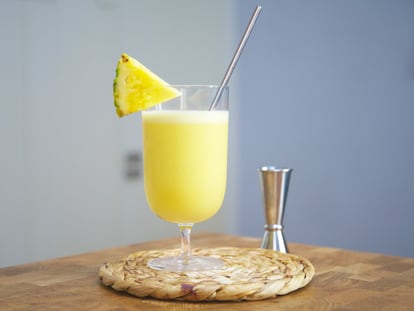Why is the Negroni the most consumed cocktail in the world?
Here are some stories and curiosities of one of the most perfect beverages in existence, which has become the most demanded in recent years

The essence of a Negroni should never be questioned: a bitter, vermouth, and a distillate such as gin, which adds complexity and structure. “Its diffusion and longevity lies in the simplicity of the recipe, with the same proportions, and the musicality of the name,” notes Luca Picchi, author of the most ambitious biography ever written about this cocktail, born in his home city, Florence. “Easy to prepare, easy to remember and easy to order by pronouncing it in any language,” he says.
Although, as he well recalls in his book, Negroni Cocktail. An Italian Legend, the original recipe, created one day in 1919 or 1920 by bartender Fosco Scarselli for Count Camillo Negroni, included seltzer, widely used at the time. “In those years, the most popular Italian cocktail was the Americano, which was made in a glass called a campanella and had vermouth (about 40 ml) and Campari (about 20 ml) and a splash of seltzer (about 40 ml),” Picchi recounts via email. “When Camillo Negroni suggested a new formula to the bartender, whispering in his ear to reduce the amount of seltzer and add a part of gin, the famous Negroni was born.”

Today, the cocktail has gained popularity thanks to all kinds of bartenders who recommend it, as well as viral videos where influencers or actors such as Stanley Tucci can be seen preparing it, and because the quality of its ingredients has improved. “In the last 20 years gin, vermouth and, even to a lesser extent, bitters, have undergone a radical revolution,” notes Picchi, who works behind the bar of Café Gilli, a legendary Florentine café, very close to the original place where Count Camillo Negroni used to go to drink, the Caffè Casoni. This year, this space was reopened under the name of Giacosa1815, which was the name given to the first café to be located there. Among the different Negronis that can be tasted there, there is a Seltz Negroni, with Monkey 47 gin, Punt E Mes, Campari and seltzer; a negroni shaken in a cocktail shaker, called Shakerato, served in a cocktail glass and made with Turin gin, Seven Hills, Carpano Antica Formula and Campari; and their most classic Negroni, with Porter’s Classic, Mancino Vermouth and Campari, slightly increasing the amount of the latter.
A Negroni has endless variations. “Like many classics, it’s a cocktail that’s designed to twist. That is, to change itself,” notes Picchi, who lists among his favorite Negronis one that substitutes mezcal for gin and adds 10 ml of Varnelli coffee liqueur. “For me, the concept of variation is broad, but it must necessarily recall, in some way, the original recipe. It must be recognizable at the first sip.”
Salvatore Calabrese — one of the world’s top mixology eminences at the helm of such prestigious London bars as the Dukes, the Playboy, or the Urban — recalls how he created one of his most replicated versions: the Negroni Svegliato. “I invented [it] in 2012, when I opened my cocktail bar at The Cromwell hotel in Las Vegas. The idea came to me while I was having my coffee, I wanted to create a cocktail that had a base of this and was elegant.” To do so, he replaced the water in an Italian coffee pot with vermouth, such that “the aroma of cinnamon, cloves and all the spices that are normally found in vermouth went through the coffee.”
Calabrese’s memories travel back to the late 1960s, when between the ages of 11 and 15 he tended bar at a small bar in his hometown during the summers. “The Negroni made a big mark on me when I started working in hospitality. My boss at the time, Mr. Raffaello, taught me a lot of things, including how to make a simple Americano long before I learned how to master cocktails,” he notes. That decade, and the previous one, served to expand the Negroni, which was quickly recognized internationally. For example, James Bond visits Rome and its hotels, the Excelsior and the Colomba d’Oro, where he meets double agent Aris Kristatos, and asks: “A Negroni. With Gordon’s, please.” Ian Fleming narrates this in the short story “Risiko,” included in For Your Eyes Only, published in 1960. Another writer who enjoys putting his characters in front of a Negroni is Tennesse Williams: in The Roman Spring of Mrs. Stone, made into a film in 1961, his protagonist drinks a Negroni in a nightclub.
That Rome, the one immortalized in films such as Rome Holiday or La Dolce Vita, would go on to become the best ambassador of the Negroni. Also, its bartenders, such as Victor Tombolini, who was behind the Open Gate, Victor’s Bar and Club 84; Valentino Clementi, at Caffè Rosati; Muro Lotti, at the Gran Hotel Roma; and Raimondo, at the aforementioned Excelsior, where it is said that he gave life to the Cardinale, one of the most popular variations of the Negroni, changing the red vermouth for dry vermouth.

For Robert Simonson, responsible for some of the best treatises on bartending ever written, author of the recent The Encyclopedia of Cocktails: The People, Bars & Drinks, with More Than 100 Recipes (2023), it’s been bartenders who have managed to position the Negroni as one of the great classics of the present. “In the 2000s, bartenders promoted drinks they liked and thought were underrated. These included gin, vermouth and Italian bitters and amaros,” he reflects. “The Negroni contains all three. So by serving Negronis, bartenders were conveying to their customers three products they loved and respected.” Simonson adds: “Almost all the cocktails and drinks we enjoy today are because a group of bartenders decided, ten or twenty years ago, to champion them and serve them more.” “Let’s not let Campari tell us that it was them who made the Negroni popular,” the journalist who writes about cocktails, spirits, bars, and bartenders for The New York Times says.
“With a lot more gin.” That’s how Ivy Mix — the visible face of cocktail bars like Leyenda and Fiasco, both in Brooklyn — likes to drink it. “I think the best Negroni I ever had was at the old Nomad in Manhattan. Leo Robitscheck was the one who made the cocktails. If you were lucky enough to have him make it special, you’ll know what I’m talking about,” she recalls from Sydney, where she is a guest cocktail bar.
Maroš Dzurus — owner of Himkok, the tiny Oslo bar that recently skyrocketed on The World’s 50 Best Bars list, moving from 43rd to 10th place — says he likes to make it with his own gin, a local wine made from strawberry and rhubarb, Anikonik, and a non-alcoholic vermouth. “This Negroni is kind of like a beginner’s Negroni because it’s a great option for first-timers,” he describes.

This year, as has been customary for the past decade, Drinks International magazine, one of the most prominent in the spirits sector, made its renowned list of the most consumed cocktails worldwide. To compile it, they ask a hundred bars in 33 countries what their ten most popular classic cocktails are. And, for the second year in a row, the Negroni took the throne. “This quintessentially Italian apéritif has become ubiquitous of late, and for good reason,” wrote journalist Clinton Cawood. “It’s definitely a golden age for the Negroni,” notes David Wondrich, the most relevant historian of the cocktail universe, editor of The Oxford Companion to Spirits and Cocktails (Oxford University Press, 2021), the bible of good drinking.
“It’s both simple and complex, yet refreshing,” opines Philip J. Greene, author of two of the works that best document the decade in which the Negroni appeared: A Drinkable Feast (2018) and To Have and Have Another (2015). “Fifteen years ago, when I first discovered this drink, it wasn’t very common to see it, but that has certainly changed,” he says.
One of the latest books on the Negroni and its history, The Negroni: A Love Affair with a Classic Cocktail (2021), is written by luxury journalist Matt Hranek. His view, removed from the sometimes cramped bar ecosystem, is also instructive: “It’s become a pet drink in the world of men’s style,” he says somewhat pejoratively. A Negroni to pretend or a negroni to drink, the die is cast in the age of social media.
Sign up for our weekly newsletter to get more English-language news coverage from EL PAÍS USA Edition
Tu suscripción se está usando en otro dispositivo
¿Quieres añadir otro usuario a tu suscripción?
Si continúas leyendo en este dispositivo, no se podrá leer en el otro.
FlechaTu suscripción se está usando en otro dispositivo y solo puedes acceder a EL PAÍS desde un dispositivo a la vez.
Si quieres compartir tu cuenta, cambia tu suscripción a la modalidad Premium, así podrás añadir otro usuario. Cada uno accederá con su propia cuenta de email, lo que os permitirá personalizar vuestra experiencia en EL PAÍS.
¿Tienes una suscripción de empresa? Accede aquí para contratar más cuentas.
En el caso de no saber quién está usando tu cuenta, te recomendamos cambiar tu contraseña aquí.
Si decides continuar compartiendo tu cuenta, este mensaje se mostrará en tu dispositivo y en el de la otra persona que está usando tu cuenta de forma indefinida, afectando a tu experiencia de lectura. Puedes consultar aquí los términos y condiciones de la suscripción digital.
More information
Últimas noticias
Most viewed
- Sinaloa Cartel war is taking its toll on Los Chapitos
- Reinhard Genzel, Nobel laureate in physics: ‘One-minute videos will never give you the truth’
- Oona Chaplin: ‘I told James Cameron that I was living in a treehouse and starting a permaculture project with a friend’
- Why the price of coffee has skyrocketed: from Brazilian plantations to specialty coffee houses
- David King, chemist: ‘There are scientists studying how to cool the planet; nobody should stop these experiments from happening’











































